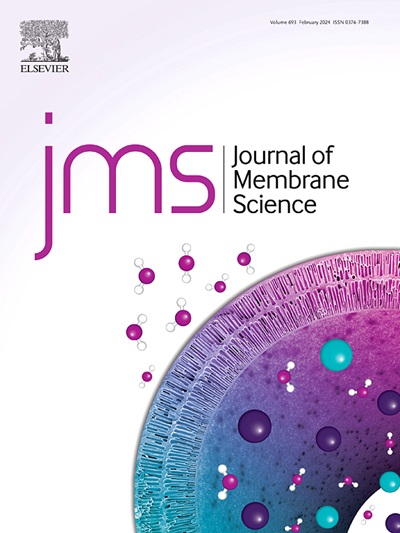低碳资源回收途径:源自废纸纸浆的纤维素纳米晶体(CNCs)膜用于高效地表水处理
IF 9
1区 工程技术
Q1 ENGINEERING, CHEMICAL
引用次数: 0
摘要
本研究展示了一种资源再利用和环境友好的生产途径,即从废纸纸浆中提取可持续材料纤维素纳米晶体(CNCs),并制备具有亲水表面和负电荷的CNCs膜。通过手性结构将纳米颗粒与聚乙烯醇(PVA)结合,并与戊二醛交联形成纳米颗粒膜,具有高渗透通量(7-25.2 Lm−2h−1bar−1)、优异的分离效率和对天然有机物(NOM)的抗污染性能。采用三种组合滤饼过滤模型研究了活性炭膜的污染行为。值得注意的是,尽管cnc膜的污染行为符合饼过滤-完全堵塞模型(CFCBM),但饼层沉淀的贡献大于孔阻塞机制。此外,通过生命周期评价(LCA)对cnc膜的环境影响进行了评价,结果表明cnc膜具有较低的环境影响水平和技术经济成本。这项工作介绍了一种新的方法来设计和应用可持续材料在膜制造。本文章由计算机程序翻译,如有差异,请以英文原文为准。

A low-carbon resource recycling pathway: cellulose nanocrystals (CNCs) membranes derived from waste paper pulp for efficient surface water treatment
In this work, a resource reuse and environmentally friendly production pathway was demonstrated that extracting sustainable materials cellulose nanocrystals (CNCs) from waste paper pulp and fabricate CNCs membranes with hydrophilic surfaces and negative charges. CNCs membranes was formed through chiral structure of CNCs particles combined with polyvinyl alcohol (PVA) and crosslinked with glutaraldehyde, exhibiting high permeation flux (7–25.2 Lm−2h−1bar−1), excellent separation efficiency and antifouling performance against natural organic matter (NOM). Three combined cake-filtration models were applied to investigate the fouling behavior of the CNCs membranes. Notably, although the fouling behavior of CNCs membranes was consistent with cake filtration-complete blockage model (CFCBM), the contribution from cake layer precipitation was observed to be greater than that of pore-blocking mechanisms. Moreover, life cycle assessment (LCA) was conducted to evaluate the environmental impact of CNCs membranes, revealing that CNCs membranes exhibited lower environmental impact level and technoeconomic cost. This work introduces a novel approach to the design and application of sustainable materials in membrane fabrication.
求助全文
通过发布文献求助,成功后即可免费获取论文全文。
去求助
来源期刊

Journal of Membrane Science
工程技术-高分子科学
CiteScore
17.10
自引率
17.90%
发文量
1031
审稿时长
2.5 months
期刊介绍:
The Journal of Membrane Science is a publication that focuses on membrane systems and is aimed at academic and industrial chemists, chemical engineers, materials scientists, and membranologists. It publishes original research and reviews on various aspects of membrane transport, membrane formation/structure, fouling, module/process design, and processes/applications. The journal primarily focuses on the structure, function, and performance of non-biological membranes but also includes papers that relate to biological membranes. The Journal of Membrane Science publishes Full Text Papers, State-of-the-Art Reviews, Letters to the Editor, and Perspectives.
 求助内容:
求助内容: 应助结果提醒方式:
应助结果提醒方式:


